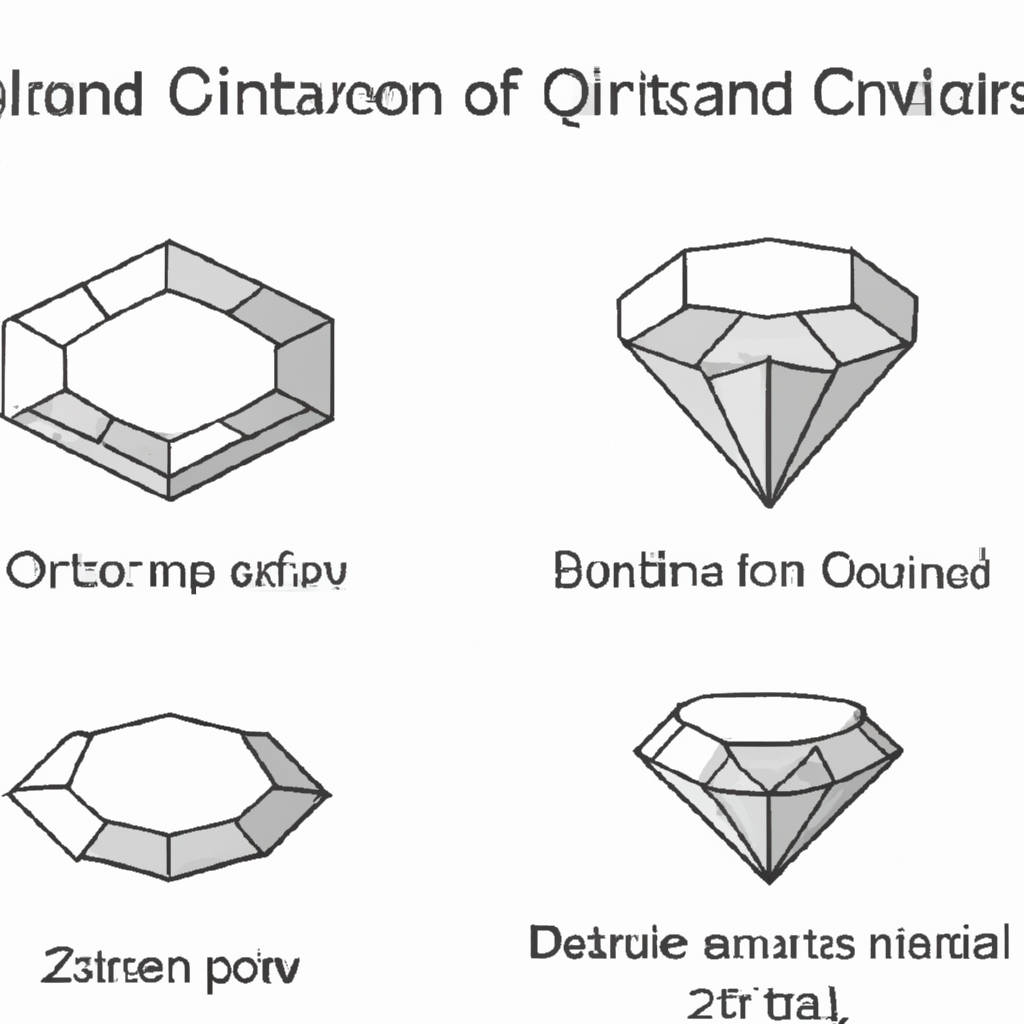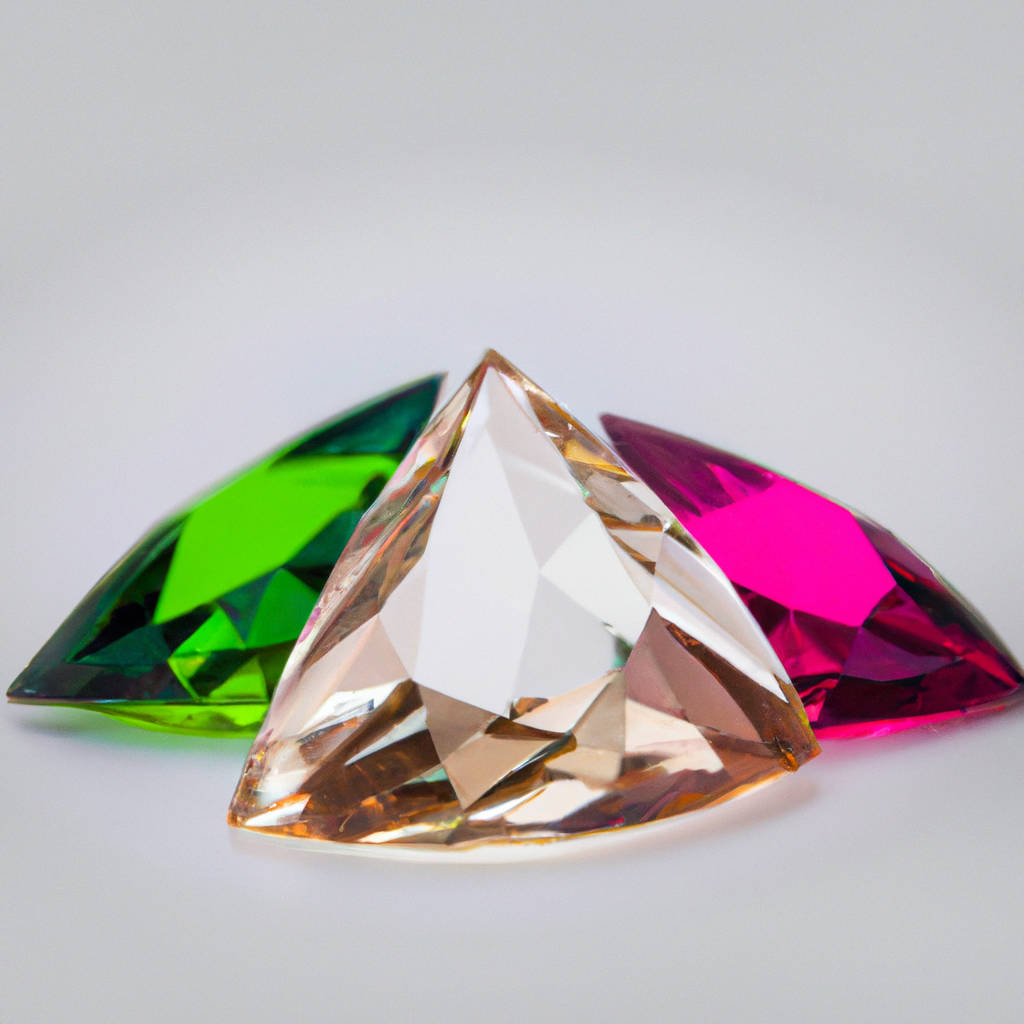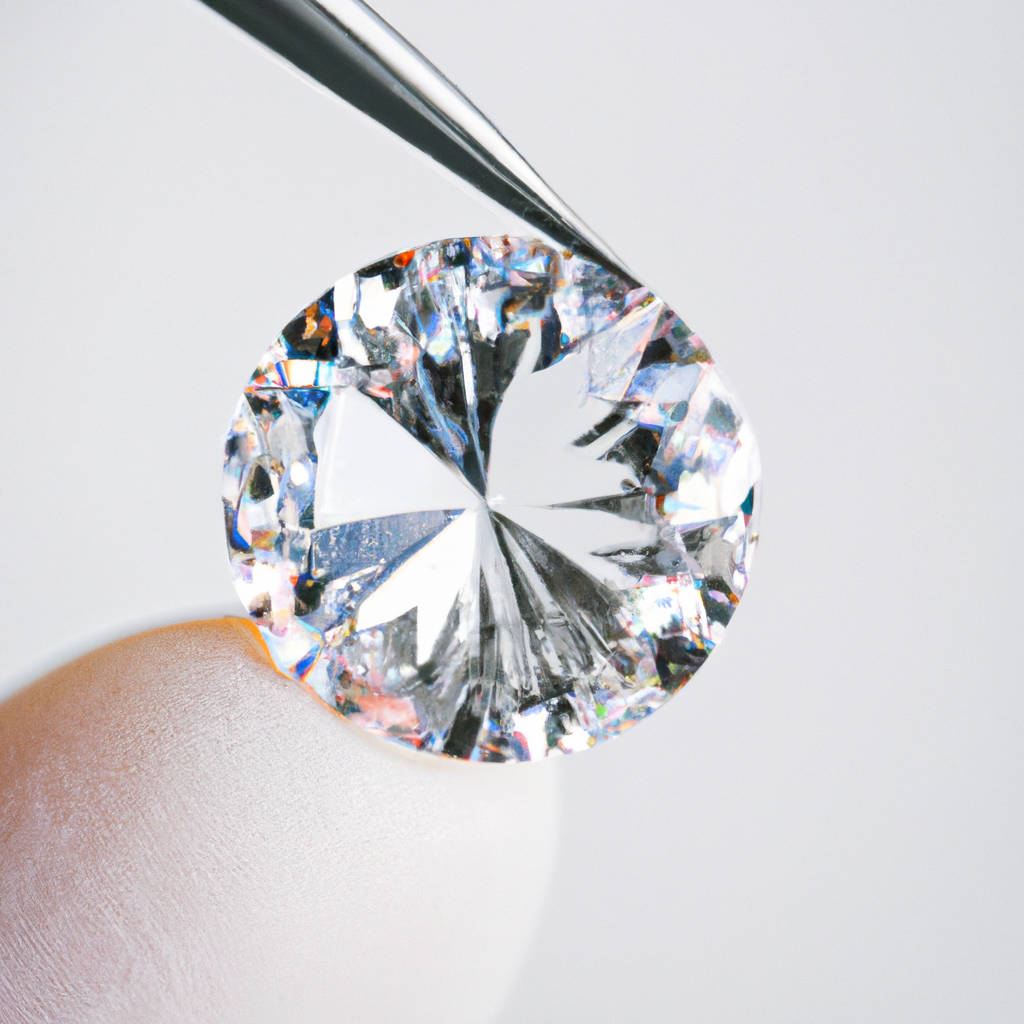Cubic Zirconia (CZ) is a synthetic gemstone that possesses a striking resemblance to diamonds. It is widely popular in the jewelry industry due to its remarkable properties and characteristics. CZ is composed of zirconium dioxide, a crystalline substance that is carefully crafted to mimic the brilliance and fire of a diamond.
One of the most appealing features of CZ is its remarkable hardness. It ranks at 8.5 on the Mohs scale of mineral hardness, making it highly durable and resistant to scratches. This property ensures that CZ jewelry retains its luster and beauty over time, even with regular wear. Additionally, CZ has a high refractive index, meaning that it is adept at bending light and creating vibrant flashes of color. This characteristic adds to the stone’s overall brilliance and gives it a captivating sparkle.
Cubic Zirconia also boasts an impressive range of colors. While the most common CZ variety is clear and colorless, it can be easily synthesized in various hues, including pink, yellow, blue, and even black. This versatility allows jewelry designers to create pieces that match individual preferences and cater to a wide range of fashion trends.
Another notable characteristic of CZ is its affordability. Unlike natural diamonds, CZ is more accessible to a broader range of consumers due to its lower production cost. This affordability factor has made it a popular choice for engagement rings, earrings, and other jewelry pieces, as it provides a cost-effective alternative to genuine diamonds without compromising on aesthetics.
Furthermore, CZ is known for its excellent clarity. The synthetic nature of this gemstone ensures that it is virtually free from inclusions or flaws commonly found in natural diamonds. As a result, CZ displays exceptional transparency and a flawless appearance, adding to its allure and desirability.
Overall, the properties and characteristics of Cubic Zirconia make it a highly sought-after gemstone in the world of jewelry. Its hardness, refractive index, color range, affordability, and clarity contribute to its widespread popularity. With its stunning resemblance to diamonds, CZ offers a captivating and budget-friendly option for those seeking elegance and sophistication in their jewelry collection.

History of Cubic Zirconia
Cubic Zirconia (CZ), a synthetic gemstone, has a fascinating history that dates back to the late 19th century. It all began when a German mineralogist named Friedrich Kronstadt stumbled upon a rare mineral known as baddeleyite. This mineral, composed of zirconium oxide, caught the attention of scientists due to its similarity to the naturally occurring diamond.
Initially, baddeleyite was used solely for industrial purposes. However, in the 1970s, Russian scientists made a groundbreaking discovery. They found a way to produce a gem-quality material by heating the baddeleyite at incredibly high temperatures, resulting in the creation of cubic zirconia. This innovation was a major breakthrough in the field of gemology.
Cubic Zirconia quickly gained popularity due to its brilliance and affordability. It possesses a similar visual appeal to that of a diamond, with its dazzling clarity and vibrant sparkle. This characteristic made it an attractive alternative for those who desired the elegance and sophistication of diamond jewelry, but without the exorbitant price tag.
Throughout the 20th century, the production of CZ expanded rapidly. Initially, it was mainly produced in the Soviet Union, but its popularity soon spread worldwide. Today, CZ is manufactured in various countries across the globe, including the United States, China, and Thailand. This widespread production has made CZ accessible to people from all walks of life.
Cubic Zirconia has found its place in the world of fashion and adornment. It has become a popular choice for engagement rings, earrings, and necklaces, allowing individuals to express their personal style without breaking the bank. Moreover, its durability and resistance to scratches make it a practical choice for everyday wear.
In recent years, advancements in technology have further enhanced the quality of CZ. With the advent of computer-aided design and manufacturing techniques, jewelers can now create intricate and intricate designs that were once only possible with natural gemstones. This has opened up a world of possibilities for jewelry designers and consumers alike.
However, it is important to note that while CZ may resemble a diamond, it is a distinct gemstone with its own unique properties. Unlike diamonds, which are formed deep within the Earth’s crust over millions of years, CZ is created in a laboratory setting. This distinction is crucial in appreciating the beauty and value of both natural and synthetic gemstones.
In conclusion, the history of cubic zirconia is a testament to human ingenuity and the desire for accessible beauty. From its humble beginnings as a byproduct of industrial processes, CZ has evolved into a widely cherished gemstone. Its affordability and brilliance have made it a popular choice among jewelry enthusiasts worldwide. As technology continues to advance, the future of CZ looks promising, with even more stunning designs and innovations on the horizon.
Cubic Zirconia Colours
Cubic Zirconia Colors: Enhancing the Sparkle of Simulated Diamonds
When it comes to dazzling jewelry, nothing can quite match the brilliance and allure of diamonds. However, the high price tag associated with these precious gemstones often makes them unattainable for many individuals. Thankfully, the advent of cubic zirconia has provided an exquisite and affordable alternative. Cubic zirconia, also known as CZ, is a synthetic gemstone that closely resembles the sparkle and clarity of diamonds. What makes cubic zirconia even more captivating is the wide array of colors available, allowing individuals to express their unique style and personality.
One of the remarkable qualities of cubic zirconia is its ability to mimic various colored gemstones, making it a versatile choice for jewelry design. While the classic clear CZ stones emulate the brilliance of diamonds, colored cubic zirconia stones offer a vibrant and eye-catching alternative. These colors are achieved through the addition of specific elements during the manufacturing process, resulting in a spectrum of hues that can range from subtle pastels to vivid tones.
The most popular colors of cubic zirconia include blue, pink, yellow, green, purple, and black. Each hue has its own unique charm and can be chosen to match individual preferences, fashion trends, or even birthstone affiliations. For instance, blue cubic zirconia can be reminiscent of a serene sapphire, while pink CZ can exude a delicate and feminine charm. Yellow CZ stones can bring a touch of warmth and radiance, green CZ can evoke images of nature and vitality, purple CZ can add a regal touch, and black CZ can exude a mysterious elegance.
The process of coloring cubic zirconia involves introducing specific metallic oxides or other elements into the crystal lattice structure of the stones. This method allows for a high level of control over the resulting color, ensuring the vibrancy and consistency of the gemstones. Additionally, the coloration is permanent and does not fade over time, ensuring that the beauty of the cubic zirconia jewelry is long-lasting.
Colored cubic zirconia stones are commonly used in various types of jewelry, including rings, earrings, pendants, and bracelets. Their versatility allows for endless possibilities in creating unique and personalized pieces. Whether it’s a statement cocktail ring adorned with a large colored CZ stone or a delicate pair of earrings featuring a subtle pastel shade, these gems offer a remarkable sparkle that can instantly elevate any outfit.
The affordability of cubic zirconia, combined with the wide array of colors available, makes it an appealing choice for those seeking to add a touch of luxury to their collection without breaking the bank. With colored cubic zirconia, one can experiment with different shades and designs, allowing for a diverse range of jewelry options for any occasion.
In conclusion, the availability of colored cubic zirconia stones has revolutionized the world of jewelry, offering an affordable and dazzling alternative to diamonds and other gemstones. The wide spectrum of hues allows individuals to express their unique style and preferences, while the permanent coloration ensures the longevity of their jewelry pieces. Whether it’s a striking blue, a delicate pink, or any other color in between, cubic zirconia provides an opportunity for everyone to shine and embrace their individuality.

Cubic Zirconia Clarity and Cut
Cubic Zirconia, a synthetic gemstone that closely resembles a diamond, has gained immense popularity over the years. Its stunning appearance, affordability, and durability have made it a top choice for individuals seeking a glamorous alternative to natural diamonds.
When it comes to evaluating the quality of a cubic zirconia, two essential factors to consider are clarity and cut. These characteristics greatly impact the stone’s brilliance and overall visual appeal. Let’s delve deeper into each of these aspects and explore their significance in the world of cubic zirconia gemstones.
Clarity refers to the presence of any flaws or inclusions within the stone. In natural diamonds, clarity is a crucial factor that determines their value. However, when it comes to cubic zirconia, the concept of clarity is slightly different. Since cubic zirconia is a laboratory-grown gemstone, it is almost always flawless. This means that there are rarely any visible inclusions or blemishes that would compromise the stone’s beauty.
The absence of flaws in cubic zirconia allows for maximum light refraction and reflection. As light enters the stone, it bounces off the facets and creates a stunning display of brilliance and sparkle. This is why cubic zirconia is often praised for its outstanding clarity and exceptional optical properties. Whether it’s under natural sunlight or artificial lighting, a high-quality cubic zirconia will always catch the eye with its dazzling radiance.
Moving on to the cut, it plays a vital role in enhancing the beauty of any gemstone, including cubic zirconia. The cut refers to the way a gemstone is shaped and faceted. A well-cut cubic zirconia will have precise angles and proportions, allowing light to enter and exit the stone optimally. This ensures that the light is properly dispersed, resulting in a scintillating display of colors and reflections.
The cut of a cubic zirconia also affects its overall shape and symmetry. The most popular cut for cubic zirconia is the round brilliant, which closely resembles the cut of a natural diamond. Other common cuts include princess, cushion, oval, and emerald, among others. Each cut has its own unique characteristics, and choosing the right one depends on personal preference and the desired aesthetic.
To achieve the best cut, skilled craftsmen use advanced cutting techniques and precision tools. The goal is to create facets that allow for maximum light interaction and brilliance. A well-cut cubic zirconia will exhibit a vibrant play of colors, excellent symmetry, and a captivating sparkle that rivals natural gemstones.
In conclusion, when it comes to cubic zirconia, clarity and cut are two essential factors that contribute to its overall beauty and visual appeal. While clarity in natural gemstones refers to the absence of inclusions, cubic zirconia is almost always flawless, ensuring exceptional clarity. On the other hand, the cut of cubic zirconia determines its shape, symmetry, and ability to reflect light, resulting in a dazzling display of brilliance.
Whether you’re looking for an affordable engagement ring, a stunning pendant, or a pair of earrings, considering the clarity and cut of cubic zirconia will help you find a piece of jewelry that exudes elegance and sophistication. With its remarkable clarity and expertly crafted cuts, cubic zirconia continues to captivate jewelry enthusiasts worldwide, offering a glamorous alternative to natural gemstones.
Cubic Zirconia Care and Cleaning
Cubic Zirconia Care and Cleaning: Enhancing the Brilliance
Cubic zirconia, commonly known as CZ, is a synthetic gemstone that bears a striking resemblance to diamonds. It has become a popular choice for jewelry enthusiasts due to its affordability, durability, and remarkable brilliance. To maintain the exquisite beauty of your CZ jewelry, proper care and cleaning are essential. In this article, we will explore the best practices for caring for and cleaning cubic zirconia, ensuring its long-lasting radiance.
First and foremost, it is crucial to handle your cubic zirconia jewelry with care. While CZ is highly durable, it is not impervious to damage. Avoid exposing your jewelry to harsh chemicals, extreme temperatures, or excessive pressure. When engaging in physical activities or household chores, it is advisable to remove your CZ jewelry to prevent any accidental scratches, chips, or other potential damage. By treating your CZ jewelry with gentleness and respect, you can preserve its brilliance for years to come.
Regular cleaning of cubic zirconia is necessary to maintain its stunning appearance. To keep your CZ jewelry looking its best, a simple and effective cleaning routine is recommended. Begin by preparing a gentle cleaning solution using warm water and a mild, non-abrasive soap. Avoid using harsh detergents or abrasive cleaners, as they can potentially damage the surface of the CZ. Let your CZ jewelry soak in the soapy water for a few minutes, allowing any dirt or debris to loosen. Gently scrub the jewelry with a soft toothbrush or a cloth, paying close attention to hard-to-reach areas. Rinse the jewelry thoroughly under warm water, ensuring that no soap residue remains. Finally, pat dry your CZ jewelry with a soft, lint-free cloth, taking care to avoid any vigorous rubbing that may cause scratches.
In addition to regular cleaning, it is essential to store your cubic zirconia jewelry properly. When not in use, store your CZ jewelry in a clean and dry place, away from other items that may scratch or damage it. Individual jewelry pouches or boxes are ideal for preventing any accidental contact between pieces. Moreover, consider keeping your CZ jewelry separate from other gemstone pieces to avoid potential scratching or dulling. By storing your cubic zirconia jewelry correctly, you can minimize the risk of damage and maintain its brilliance.
While cubic zirconia is resistant to most chemicals, exposure to certain substances should be avoided. Perfumes, lotions, hairsprays, and other beauty products often contain chemicals that can dull the shine of CZ. To preserve the brilliance of your CZ jewelry, it is advisable to apply these products before wearing your jewelry. In doing so, you can prevent any potential chemical interactions that may affect the appearance of your cubic zirconia.
Furthermore, periodic professional cleaning and inspection of your CZ jewelry are highly recommended. Jewelers possess the expertise and specialized equipment to thoroughly clean and assess the condition of your cubic zirconia pieces. Through professional cleaning, any deep-seated dirt or grime can be effectively removed, restoring the brilliance of your CZ jewelry. Additionally, jewelers can detect any loose stones or potential issues, ensuring the longevity of your cherished pieces.
In conclusion, caring for and cleaning cubic zirconia jewelry is vital to maintain its captivating brilliance. By handling your CZ jewelry with care, regularly cleaning it using gentle methods, storing it properly, and avoiding exposure to certain substances, you can preserve its stunning appearance for years to come. Embrace the affordability and allure of cubic zirconia by following these guidelines, and allow your jewelry to continue shining as a testament to your impeccable taste.

